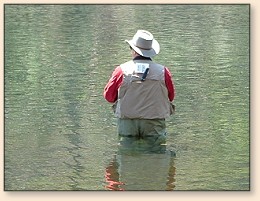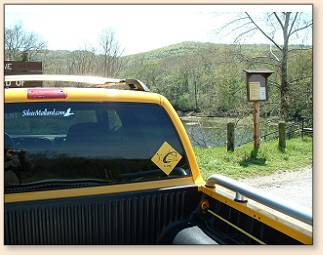|
The trout species found in the Ozarks fisheries
are mostly Rainbows and Browns, but there are
limited numbers of Brook Trout, Cutthroats, and
Cutbows to be found in some waters...mostly on
the Arkansas side of the border. A typical
Rainbow will measure between 11 and 15 inches,
while a common Brown trout landed on the fly
will measure around 15 inches. Trophy fish are
generally considered anything over 20 inches.
Browns are the more popular trophy species, and
have been landed and recorded with great frequency
in excess of 20 pounds from the North Fork, the
White River below Bull Shoals dam, and on Taneycomo
below Table Rock dam. The North Fork produced the
current IGFA record Brown Trout, the Little Red River
is well known for producing large Brown and Rainbow
Trout as well.

The communities which tend to serve as the hubs
for fly anglers in the region are Mountain Home
and Flippin, Arkansas, and Branson, Missouri.
But these are by no means the only three
destinations worth visiting. One of the nicest
features of the Ozarks region for fly anglers is
the shear menagerie of locales and variety of
options available that are fairly densely packed
into an area roughly 100 miles East-to-West by
50 miles North-to-South. Anglers can fish a
spring-fed stream like the Spring River for
Rainbows and Cutthroat one day and chase trophy
Browns on the White River the next. Follow that
with a float down the North Fork the following day.
Then drive over to wade the Little Red River the
day after. The next day, drive up to Beaver or
Taneycomo and fish for Rainbows on the Missouri
side of the border. The Ozarks offers a virtual
smorgasbord of trout angling opportunities with
some of the lowest non-resident license prices,
lodging rates, and guide rates in the country.

Each of the Ozarks' cold-water fisheries is unique
and has its own variety of nymphs, streamers, wet,
and dry flies that produce well under specific
conditions. The majority of the fly-fishing takes
place on various tailwaters of the White River system
of dams. Beaver Dam, Table Rock Dam, Powersite Dam,
Bull Shoals Dam, Greer's Ferry Dam, and Norfork Dam
all form quality tailwater fisheries along the
Arkansas and Missouri border. Like most tailwater
fisheries, power generation at the dams impacts
fishing tactics more than any other single factor.
But each fishery also changes with the seasons,
the weather, and the fishing pressure. The angler
who wants to catch good numbers of quality fish
year-round on these fisheries must develop a
varied arsenal of tactics and fly patterns to
address these changing conditions. The conventional
wisdom among fly anglers in the Ozarks is that the
heart and soul of fly-fishing the region's cold-water
fisheries are the sowbug and scud. Yet another group
seems devoted to a relatively narrow assortment of
small streamers. But many of the top fly anglers
in the region agree that at the core of this arsenal
lie the tiny midges, which hatch daily throughout the
year on every one of these fisheries. I fall into
step with the latter group of anglers.
The preference for midge fishing is probably not
born of any demonstrable advantage in numbers or
size of fish landed. The same could be said of
a preference for the bottom-dwelling sowbug/scud
crowd or the streamer devotees. Rather, it is
most likely the product of personal preference
and individual proficiency with the tactics of
fishing that particular category of flies, and
perhaps even a penchant for tying specific flies.
All three methods produce good numbers of quality
fish when done well. And each group of anglers
must also acquire proficiency in the other two
disciplines if one is to become successful in
most places and at most times. While my fly
boxes are predominantly filled with Midge Pupae,
Zebra Midges, Partridge Soft Hackle Emergers, and
Mosquito Midge dry flies in various colors and
sizes, I must also carry and be proficient with
an assortment of scuds and Wooly Buggers. The
wise Ozark fly-fisherman will also equip himself
with a few proven dry flies of the region such as
the Crackleback and the Elk Hair Caddis.

For leaders and tippets, the successful Ozark
angler will need to carry an assortment of 5x,
6x, and 7x tippet along with at least one 12-foot
6x leader for casting dry flies and soft hackles.
Line weights basically range from 4-weight for
this type of delicate work to 7-weight for the
heavy streamers cast to cover-hugging Brown trout.
Recommended tippet and leader lengths generally
run from 10 to 15 feet, with 12 feet being
considered "ideal" by most. In the Ozarks,
most proficient anglers don't bother using a
tapered leader when nymphing. Instead, they
tend to use straight tippet material attached
directly to the fly line. The same can be said
for fishing with streamers like the Wooly Bugger.
This is by no means universal, but a clearly
evident phenomenon among resident fly anglers.
Some even prefer 2-4 lb. test monofilament fishing
line mostly due to economics and the fact that it
still works.
Buoyant foam strike indicators seem to be preferred
for nymph fishing over the yarn or putty type.
Positive buoyancy of these "bobber" type indicators
makes controlling depth much easier. Size of the
indicator is important, however, and you want to
use the smallest indicator that will float above
your terminal tackle. Achieving and maintaining
the proper depth in the water column…the one where
fish are feeding...is at least fifty percent of the
battle of good nymphing technique. The next most
important factor is maintaining a good, drag-free
drift. The first is accomplished by a combination
of proper casting technique and the right amount
of weight below the indicator, while the latter
is the product of casting and mending which can
be accomplished using a variety of upstream casting
strategies. I see more and more anglers as time
goes on fishing nymphs using a true upstream cast
and drift method, but the most productive anglers
use the up-and-across approach with an upstream
mend as the indicator comes parallel to their
position in the stream.
The soft hackle emergers are presented using an
up-and-across cast similar to that used for
nymphs, but the fly is allowed to swing in the
current creating a bow in the line until it comes
to rest directly downstream of the caster, when
it is twitch-stripped a few feet and then cast
again. The most popular soft hackle patterns are
the Partridge and Orange and Partridge and Insect
Green Soft Hackle Emergers. They can also be
"drowned" and fished shallow under a small indicator
if conditions warrant. Most soft hackle anglers
carry an assortment of soft hackle flies tied on
both emerger and dry fly hooks in sizes 16 through
24. When the fish are feeding very near the surface
film, the dry fly versions are used, while the
nymph/emerger versions are used when the fish are
feeding a few inches to a foot or so beneath the
surface.
Both in the early morning and late afternoon/evening
hours, Ozark fisheries produce limited opportunities
to catch trout on dry flies. The best patterns seem
to be the Mosquito Midge, Crackleback, and Elk Hair
Caddis. Hoppers and beetles of various sorts can
also be productive when conditions are right. But
I would estimate that roughly ten percent of the
trout landed in the Ozarks cold-water fisheries
are taken on dry flies. The vast majority are
hooked below the surface.
 Fly anglers will also find the Ozark region to
be very hospitable and "tourism-friendly."
Tourism has been one of the major industries
of the region for nearly 100 years, and the
people and culture of the Ozarks is largely
centered around vacationers. Eating
establishments, lodging, camping facilities,
and evening entertainment options abound.
So if you are looking for "new waters" to
explore, or if you haven't been here for a
while, consider the Ozarks for your next
fly-fishing adventure. Centrally located
in the United States, the Ozarks lie within
a 10-hour drive of nearly 60-percent of the
population of the country. From Chicago to
Cincinnati, from Alabama to Texas, and from
Denver to Cedar Rapids, residents can drive
to the Ozarks in a day. If you live further
away, the airports in Memphis, Little Rock,
Springfield, and even St. Louis and Kansas City
put you within easy striking distance of the
great fishing that awaits. ~ Ken
Fly anglers will also find the Ozark region to
be very hospitable and "tourism-friendly."
Tourism has been one of the major industries
of the region for nearly 100 years, and the
people and culture of the Ozarks is largely
centered around vacationers. Eating
establishments, lodging, camping facilities,
and evening entertainment options abound.
So if you are looking for "new waters" to
explore, or if you haven't been here for a
while, consider the Ozarks for your next
fly-fishing adventure. Centrally located
in the United States, the Ozarks lie within
a 10-hour drive of nearly 60-percent of the
population of the country. From Chicago to
Cincinnati, from Alabama to Texas, and from
Denver to Cedar Rapids, residents can drive
to the Ozarks in a day. If you live further
away, the airports in Memphis, Little Rock,
Springfield, and even St. Louis and Kansas City
put you within easy striking distance of the
great fishing that awaits. ~ Ken
About Ken:
Ken graduated from Southern Methodist University
in 1988, and spent the next several years serving
in the United States Navy as an intelligence analyst
and Russian Language translator. He is a veteran
of Desert Shield and Desert Storm. Leaving the
nation's service in 1993.
Ken is also a published outdoor writer and historian,
having penned articles and stories that have appeared
in several national hunting publications like North
American Hunter magazine, on GunMuse.com, in regional
and local newspapers, and historical and literary
journals. He also provides hunting and dog training
seminars for Bass Pro Shops and other sporting goods
retailers nationwide and works with other outdoors
businesses and conservation organizations in the
fields of public relations, promotional marketing,
fund-raising, and advertising. He also is a partner
in Silver Mallard Properties, LLC. He currently
resides with his wife, Wilma, their Weimaraner,
Smoky Joe, and their Labrador Retriever, Jake, in
Branson, Missouri, where he founded the
Branson/Tri-Lakes Chapter of Ducks Unlimited in 1998.
|





 Fly anglers will also find the Ozark region to
be very hospitable and "tourism-friendly."
Tourism has been one of the major industries
of the region for nearly 100 years, and the
people and culture of the Ozarks is largely
centered around vacationers. Eating
establishments, lodging, camping facilities,
and evening entertainment options abound.
So if you are looking for "new waters" to
explore, or if you haven't been here for a
while, consider the Ozarks for your next
fly-fishing adventure. Centrally located
in the United States, the Ozarks lie within
a 10-hour drive of nearly 60-percent of the
population of the country. From Chicago to
Cincinnati, from Alabama to Texas, and from
Denver to Cedar Rapids, residents can drive
to the Ozarks in a day. If you live further
away, the airports in Memphis, Little Rock,
Springfield, and even St. Louis and Kansas City
put you within easy striking distance of the
great fishing that awaits. ~ Ken
Fly anglers will also find the Ozark region to
be very hospitable and "tourism-friendly."
Tourism has been one of the major industries
of the region for nearly 100 years, and the
people and culture of the Ozarks is largely
centered around vacationers. Eating
establishments, lodging, camping facilities,
and evening entertainment options abound.
So if you are looking for "new waters" to
explore, or if you haven't been here for a
while, consider the Ozarks for your next
fly-fishing adventure. Centrally located
in the United States, the Ozarks lie within
a 10-hour drive of nearly 60-percent of the
population of the country. From Chicago to
Cincinnati, from Alabama to Texas, and from
Denver to Cedar Rapids, residents can drive
to the Ozarks in a day. If you live further
away, the airports in Memphis, Little Rock,
Springfield, and even St. Louis and Kansas City
put you within easy striking distance of the
great fishing that awaits. ~ Ken